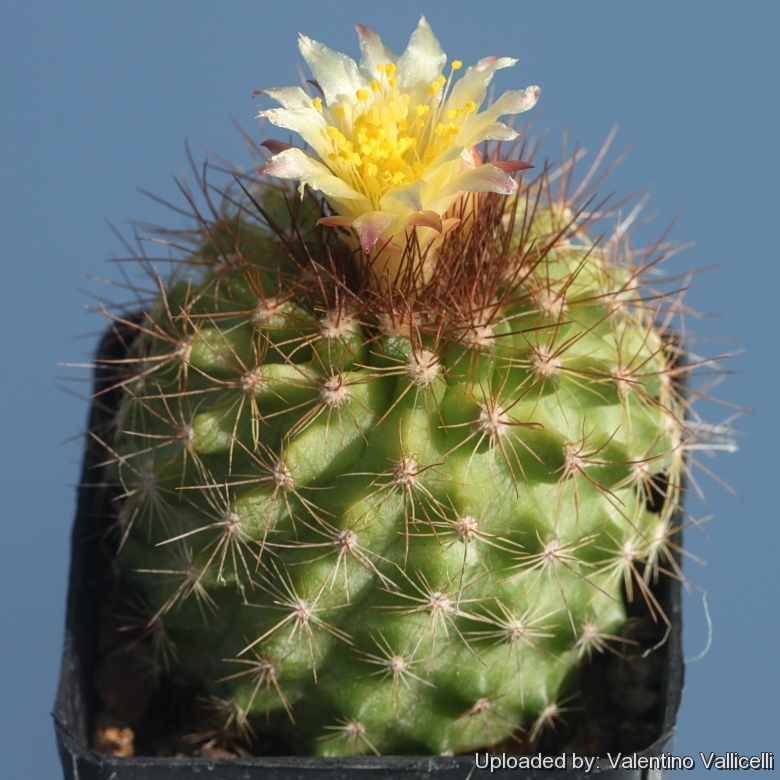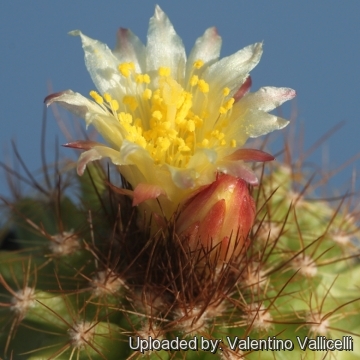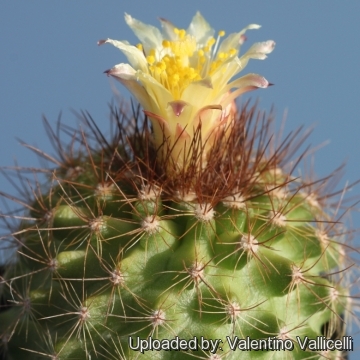
Copiapoa humilis subs. variispinata Photo by: Valentino Vallicelli
FK 382 (Collector: Friedrich Kattermann) Locality: Quebrada Botija, Chile. Altitude: 20 m.
Origin and Habitat: Near Iscuña Valley (Quebrada Izcuna on the south of Caleta Botija, between Paposo and Blanco Encalada about 50 km north of Paposo), Region II: Paposo, Antofagasta, Chile.
Altitude: usually below 300 m.
Habitat: In grows in several fragmented populations from the coast inland (4,5-6,5 km) in quebrada Iscuna (Paposo) among rocks; the subpopulations that grow at higher altitudes have influence of the frequent, often dense, coastal fogs.
Synonyms:
See all synonyms of Copiapoa humilis
Description: This subspecies is easily telling apart from other Copiapoa humilis for the unusual green body. It form clusters that are wider than hight.
Roots: Long thickened conical-rootstock going well down into the ground, with narrow neck.
Stem: Globose to slightly elongate with age, soft, green, 4-7 cm in diameter. Apex depressed covered with dense felt and spines.
Ribs: 15-18 (-22), furrows 4-6 mm deep, notched, forming more or less distinct tubercles.
Areoles: Round, with white wool 1,5-4,5 mm in diameter and 3-8 mm apart.
Radial spines: Usually 10 to 15 but very variable in number and length, thin needle-like, spreading, yellowish brown to dark brown turning grey as they ages moslty 3-8 mm long.
Central spines: 5-10 stronger and spreading in all directions 5-10 mm long (or more)
Flower Diurnal, campanulate, 2,5-3 cm diameter sulphur yellow, with characteristic Copiapoa flower-scent, sprouting out from the wool of the crown.
Subspecies, varieties, forms and cultivars of plants belonging to the Copiapoa humilis group
Bibliography: Major references and further lectures
1) Robert Silverberg “The Palace at Midnight: The Collected Stories, Volume 5“ Hachette UK, 29/Sep/2011
2) Graham Charles “Copiapoa” Cirio Pub. Services, 1999
3) Riha & Subik. “The illustrated encyclopedia of cacti and other succulents” (edited by G. & K.A. Beckett) 1981
4) James Cullen, Sabina G. Knees, H. Suzanne Cubey “The European Garden Flora Flowering Plants: A Manual for the Identification of Plants Cultivated in Europe, Both Out-of-Doors and Under Glass” Cambridge University Press, 11/ago/2011
5) Clive Innes “Complete Handbook of Cacti and Succulents” Van Nostrand Reinhold Company, 01/Dec/1981
6) Edward Anderson “The Cactus family” Timber Press, Incorporated, 2001
7) David R Hunt; Nigel P Taylor; Graham Charles; International Cactaceae Systematics Group. "The New Cactus Lexicon" dh books, 2006
8) N. L. Britton, J. N. Rose “The Cactaceae. Descriptions and Illustrations of Plants of the Cactus Family.” Volume 4, The Carnegie Institution of Washington, Washington 1923
9) F.Ritter “Kakteen Südamerika” 3: 1072 1980
 Copiapoa humilis subs. variispinata Photo by: Valentino Vallicelli
Copiapoa humilis subs. variispinata Photo by: Valentino Vallicelli Copiapoa humilis subs. variispinata Photo by: Valentino Vallicelli
Copiapoa humilis subs. variispinata Photo by: Valentino Vallicelli Copiapoa humilis subs. variispinata Photo by: Valentino Vallicelli
Copiapoa humilis subs. variispinata Photo by: Valentino VallicelliSend a photo of this plant.The gallery now contains thousands of pictures, however it is possible to do even more. We are, of course, seeking photos of species not yet shown in the gallery but not only that, we are also looking for better pictures than those already present.
Read More... Cultivation and Propagation: Considering that Copiapoa variispinataSN|9776]]SN|9776]] comes from a habitat with an extremely arid climate, they are remarkably tolerant of pot culture. These plants have thick taproots and are susceptible to overwatering. They requires also an appropriate air circulation. Copiapoas are summer grower species easy to cultivate
Growth rate: It is a relatively rapidly growing and easily flowering species that will make clumps given the best conditions.
Soils: It likes very coarse mineral cactus mix soil, but can become too elongated if compost is too rich.
Repotting: Use pot with good drainage.
Watering: Water moderately from Spring to Autumn, but do not overwater (Rot prone), it must be strictly kept dry throughout the winter quiescent period since it is very sensitive to any moisture excesses keep dry in winter.
Fertilization: Feed with a high potassium fertilizer in summer.
Hardiness: They need to be kept in a cool place during winter rest and are resistant to light frost if kept on the dry side prior to, and during, cold weather ( they are hardy to -4 C ° C short periods). However some warmth throughout the year will increase the grower's success (minimum 5° to 8°C during rest season).
Exposition: Requires full sun or light shade and careful watering to keep plant compact with strong coloured spines. Tends to bronze in strong light, which encourages flowering and heavy spine production. Light shadow my be useful in the hottest summer days.
Uses: It is an excellent plant for container growing. It always looks good and stays small. It look fine in a cold greenhouse and frame or outdoor in a rockery.
Pests & diseases: It may be attractive to a variety of insects, but plants in good condition should be nearly pest-free, particularly if they are grown in a mineral potting-mix, with good exposure and ventilation. Nonetheless, there are several pests to watch for:
- Red spiders: Red spiders may be effectively rubbed up by watering the infested plants from above.
- Mealy bugs: Mealy bugs occasionally develop aerial into the new growth among the wool with disfiguring results, but the worst types develop underground on the roots and are invisible except by their effects.
- Sciara Flies: Sciara flies are one of the major problems for seedlings. It is a good practice to mulch your seedlings with a layer of grit, which will strongly discourage the flies.
- Scales: Scales are rarely a problem. It is wise to treat your whole collection with a systemic insecticide twice a year in spring and autumn.
- Rot: Rot is only a minor problem with cacti if the plants are watered and “aired” correctly. If they are not, fungicides won't help all that much. To prevent rottenness it is also advisable to surround its root neck by very rough sand or grit, this help a fast water drainage.
Propagation: Seed, cutting, grafting. Seeds germinate in 7-14 days at 21-27° C in spring, remove gradually the glass cover as soon the plants will be well rooted (ca 1-2 weeks) and keep ventilated, no full sun for young plants!














